Nine Innings: Gleyber Torres Jolts Yankees, Jacob deGrom Sparks Never-Ending DH Debate and More

BREAKING DOWN GLEYBER TORRES'S TERRIFIC DEBUT WITH THE YANKEES
By Tom Verducci
Unlike Aaron Judge, Giancarlo Stanton and even Didi Gregorius, Gleyber Torres is not a great candidate to produce the kind of spectacular highlights that get passed around social media. But if you watch games, not just highlights, you are quickly impressed with the rookie second baseman.
Torres, at just 21, has a freakishly advanced approach to hitting. It’s exactly what the power-laden, strikeout-prone New York lineup needs to be complete. I don’t recall any player this young and this inexperienced using a wholesale different approach with two strikes as he does with no or one strike.
Before he gets to two strikes, Torres uses a big leg kick and a Javy Baez-like tip-and-rip barrel path (the barrel gets beyond his head, tipped toward the pitcher, before he whips it through). But with two strikes, Torres often ditches the leg kick and simply plants the toes of his front foot on the ground early, triggering a more controlled, direct path to the ball. He resembles a young Albert Pujols.
But look what he did Sunday: after striking out in his first at-bat with his usual two-strike swing, Torres decided to stick with his “A” swing the rest of the game. How did that work out? With two strikes, he struck out again, popped out … and smashed a walk-off home run to centerfield on a full count pitch from Dan Otero.
GLEYBER. TORRES.
— Sports Illustrated (@SInow) May 6, 2018
The rook is legit. pic.twitter.com/Yze3wsbHk5
Torres is hitting .290 with two strikes. You just don’t see hitters so young cover the plate like that. Overall, he has rapped 17 hits in his first 15 games. At 21 years and 144 days old, Torres is the second-youngest Yankee ever with that many hits in his first 15 games. The only younger Yankee to start like this was Ben Chapman (21.130) 88 years ago.
(As Phillies manager, Chapman became infamous for his brutal hazing of Jackie Robinson in 1947. As a player, his claim to fame was that the Yankees traded him in 1936 to open up centerfield for DiMaggio, and the Red Sox traded him two years later to open a spot for Ted Williams.)
Torres has arrived as advertised: a high-average, high-OBP hitter with superb defensive skills and high baseball intelligence.
“He reminds me of Javy Baez the way he plays,” Yankees manager Aaron Boone said. “He’s got a shortstop’s arm, and the way he plays with a lot of confidence. He’s a premier defender.”
As Greg Bird and Brandon Drury work their way back from injuries, rookie infielders Torres and Miguel Andujar, 23, are not going anywhere. They give even more depth to New York’s lineup and the ability to put the ball in play against good pitching.
“Torres, he’s the guy,” Boone said. “Andujar for a while has earned his spot in the big leagues. Against lefthanded pitching, he’s a dude.”
Only three Yankees teams ever featured two qualified rookies no older than 23: 1926 (Mark Koenig and Tony Lazzeri), 1925 (Lou Gehrig and Pee-Wee Wanniger) and 1920 (Bob Meusel and Aaron Ward).
BEST THING I SAW THIS WEEK: THE DODGERS' UNHERALDED YET HISTORIC NO-HITTER
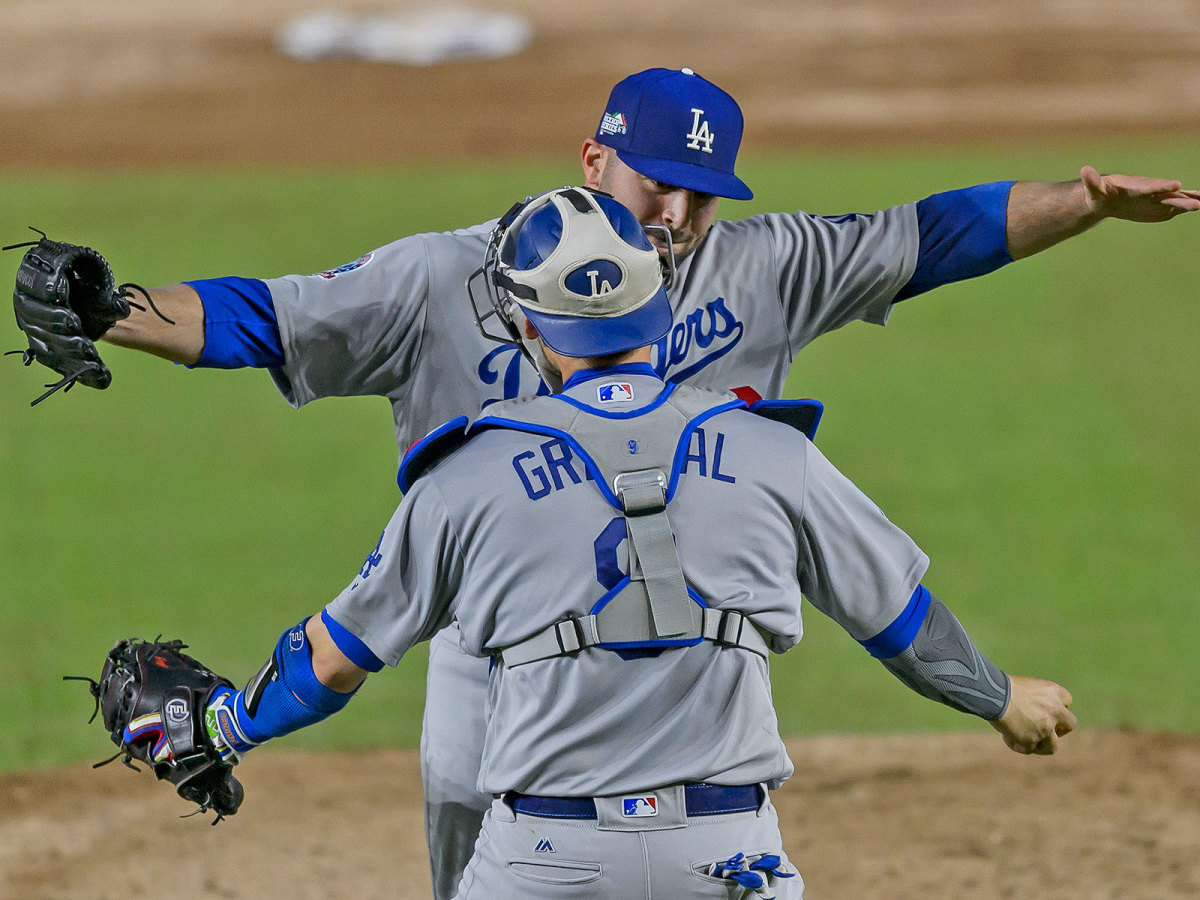
By Jon Tayler
The season is barely a month old, and already we’ve gotten two no-hitters. The first was your conventional one man standing against the tide, with Oakland’s Sean Manaea blanking the Red Sox on April 21. The second, though, was something far more rare: the combined no-hitter. This time, it was the Dodgers with the honors, stymieing the Padres (who are seemingly always on the other end of the feat they’ve never recorded themselves) in Mexico last Friday. The united efforts of rookie starter Walker Buehler, who threw the first six innings, and a trio of relievers—lefty Tony Cingrani, righty Yimi Garcia and southpaw Adam Liberatore—produced the first joint no-no since the Phillies did it to the Cubs in 2014, and only the 12th combined no-hitter in 140 years of organized baseball. To put that in perspective: There have been nearly twice as many perfect games in MLB history (23, to be exact) than there have combined no-hitters.
Yet the combined no-hitter doesn’t carry the same cachet as the perfect game, or a regular no-hitter, or other such oddities like the cycle or the four-homer game. Why? Because the combined no-hitter doesn’t carry the romantic appeal of one man etching his name in the record books; nor does it match our idealized version of what a no-hitter looks like, in which a pitcher stays in to finish it or lose it. To leave a no-hitter in progress is to fail to see the task through, and in a sport where perhaps no one is more prized than the starting pitcher who racks up outs and goes deep into the game, the idea of multiple men collaborating to do something that should belong to an individual feels like a fluke that isn’t worth celebrating.
Dodgers Place Clayton Kershaw on DL With Biceps Injury
But don’t tell that to the Dodgers, who bounced around in joyous clumps on the field after Liberatore recorded the final out of a rain-soaked night at Monterrey’s uncreatively named Estadio de Beisbol. The combined no-no may be unheralded, but its value and joy comes from someone like Liberatore being the man to finish it. The 30-year-old lefty is the kind of faceless foot soldier that makes up the game’s invisible ranks of middle relievers, utility infielders, and Quad-A outfielders: A former 21st-round pick, he only throws 90 mph and spent most of last year nursing groin and forearm injuries. He’s the type of player who almost never gets a moment in the spotlight. But there it found him in the ninth inning, as he retired Eric Hosmer, Christian Villanueva and Franchy Cordero in order to make history for his team. It’s a moment he’ll never forget in a career that could be over as soon as next year or next month or next week; such is the life of a back-of-the-bullpen reliever.
As ESPN’s Sam Miller pointed out in the wake of Manaea’s no-hitter, individual no-nos are rapidly going extinct. In an era where starters are handled more carefully than ever and rarely allowed to go through a lineup more than twice, it’s hard to find the formula necessary for one man to get 27 outs before giving up a hit. In the last few years, we’ve seen pitchers get pulled countless times from no-hitters in progress. On Sunday, Yankees rookie starter Domingo German was the latest to be hooked with the job unfinished, exiting in the sixth inning of his no-hit bid against Cleveland (which reliever Dellin Betances ultimately blew in the eighth).
If those trends hold, then the combined no-hitter could go from once-in-a-decade curio to regular occurrence. The result will be fewer heroes on their own solo missions. But that also means more happy moments for guys like Liberatore, who normally get shut out of baseball history but now could get to play a crucial part in building its future.
WHY THE DESIGNATED HITTER ISN'T COMING TO THE NATIONAL LEAGUE ANYTIME SOON
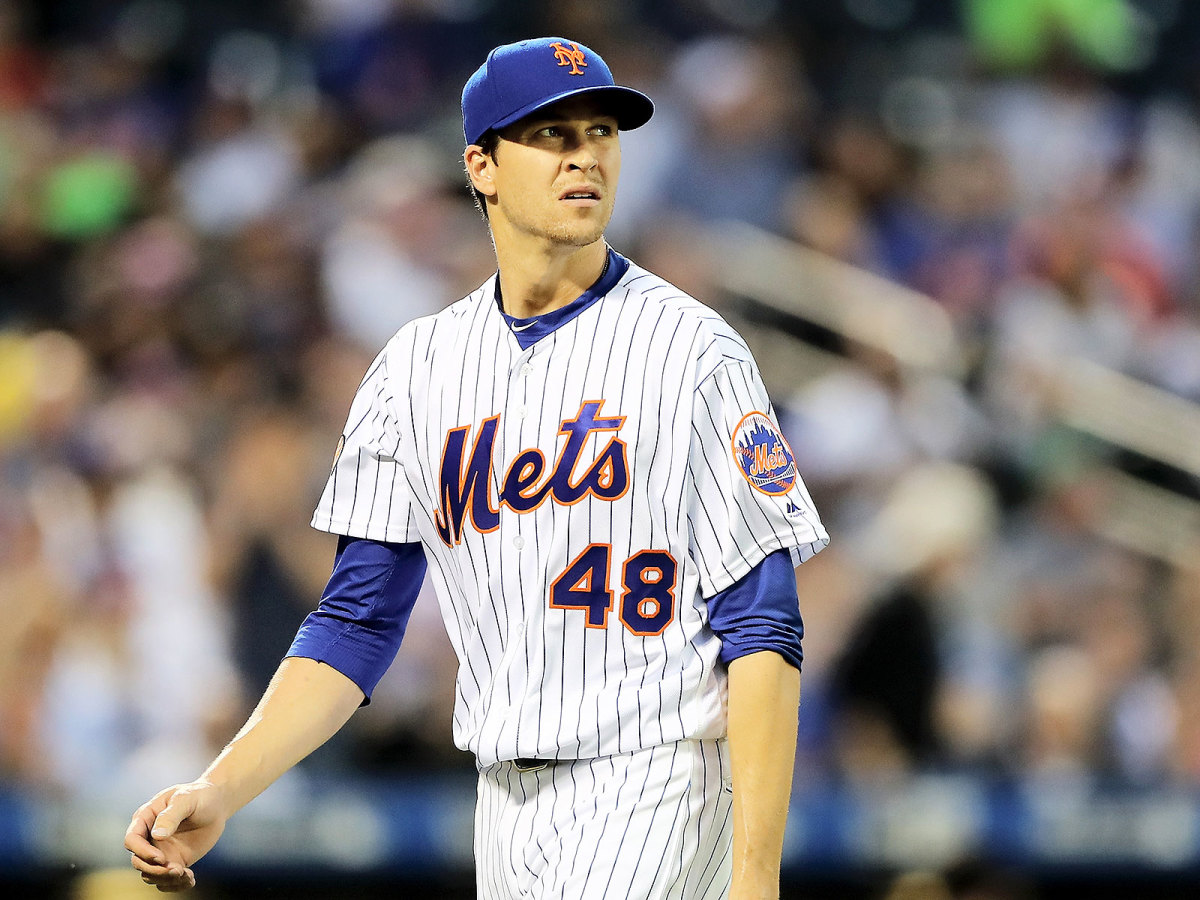
By Tom Verducci
Here we go again. Jacob deGrom injures his elbow and the helicopter pundits want to throw away the original version of baseball and shove the DH into the National League.
I would tell these reactionaries to please stop, but that won’t happen. Since the AL adopted the DH in 1973, the bleating about the DH in the NL has been non-stop. Usually it percolates when a pitcher gets hurt batting or running the bases (Mark Prior, Chien-Ming Wang, Adam Wainwright, deGrom—there actually haven’t been that many). Here’s just a sample of the incessant whining:
2016: “National League DH Seems Almost Inevitable for 2017” (N.Y. Post)
2013: “DH Will Inevitably Become the Standard Across MLB” (Honolulu Star-Advertiser)
2008: “Wang Hurt Foot Running Bases; Team Official Wants DL to Adopt DH” (Honolulu Advertiser)
1997: “NL Should Adopt DH” (Chillicothe Gazette)
1988: “Pitch to NL: Adopt DH Rule” (Florida Today)
1985: “National League Needs the Ugly DH – Right Now” (Hartford Courant)
1984: “Baseball Commissioner to Seek Fans’ Advice on Designated Hitters” (The Courier-News)
1980: “NL Expected to Adopt DH” (The Palm Beach Post)
1977 “Report National to Adopt DH” (Santa Ana Register)
1976 “NL Will Adopt DH – Bragan” (Arizona Republic)
1975 “National League to Adopt DH?” (The Pittsburgh Press)
1973: “Bowie Kuhn Hopes National League Will Adopt DH Rule” (Lebanon Daily News).
Let’s first understand why the DH rule was added in the first place: attendance was terrible in the American League. In 1972, attendance was 36% higher in the NL than in the AL (even with the NL, until 1992, announcing actual turnstile counts, not the more dubious “tickets sold”). AL owners wanted to perk up offense to get more people in the park. (They averaged just 12,312 per game in 1972).
It worked—sort of. Attendance went up 12% in the AL. But the NL, which refused to go along with the “experimental” rule, also saw an increase in attendance—by 3%.
Today there is no pressing economic incentive to add a DH to the NL. Now, people will tell you, “Who wants to see a pitcher hit?” Apparently, a lot of people. NL teams drew 11% higher than AL teams last year. This year they are outdrawing the AL by 16%.
Mets Place Jacob DeGrom on DL with Elbow Injury
Is it more offense you want? Last year AL teams batted .256. NL teams batted .254. Total bases per team per game? The AL again barely showed an edge: 14.65-14.37.
The fact is the ongoing “controversy” about the DH is good for baseball, and commissioner Rob Manfred knows it and is in no hurry to homogenize the game. If you like the DH, you already have it in the AL. If you like the original, more nuanced version of baseball, you already have it in the NL. There’s no reason to alienate a large chunk of fans by doing away with choice.
A few years ago Bob Costas and I hosted MLB’s 20 Greatest Games, a series on MLB Network. Seven of our top 10 games were played under NL rules, including the top ranked game: Game 6 of the 1975 World Series, the last game played at Fenway Park without a DH. Sparky Anderson used 12 players in the ninth spot in his batting order, including four pinch-hitters. Bernie Carbo hit his famous home run while pinch-hitting for reliever Roger Moret.
Baseball already is getting dumbed down far enough. The all-or-nothing approach to hitting and pitching has spawned a game in which more than one third of plate appearances don’t include the ball being put into play. There are more strikeouts than hits. Stolen bases and hits have hit a 46-year low. Sacrifices have hit an all-time low. Benches often include only two position players plus a backup catcher. The hit-and-run play is growing extinct.
Why push baseball further toward checkers and away from its chess-like roots? Why alienate fans? Why kill baseball the way it was meant to be played? Because once in a blue moon a pitcher gets hurt swinging a bat? Sorry, not good enough.
We already have a DH. One league is enough. The “tension” that has existed for 45 years—one league with it, one without; fans on one side or another—is not only good for the game, but also has become a tradition itself.
EXPLAINING THE ASTROS' ONE MAJOR FLAW
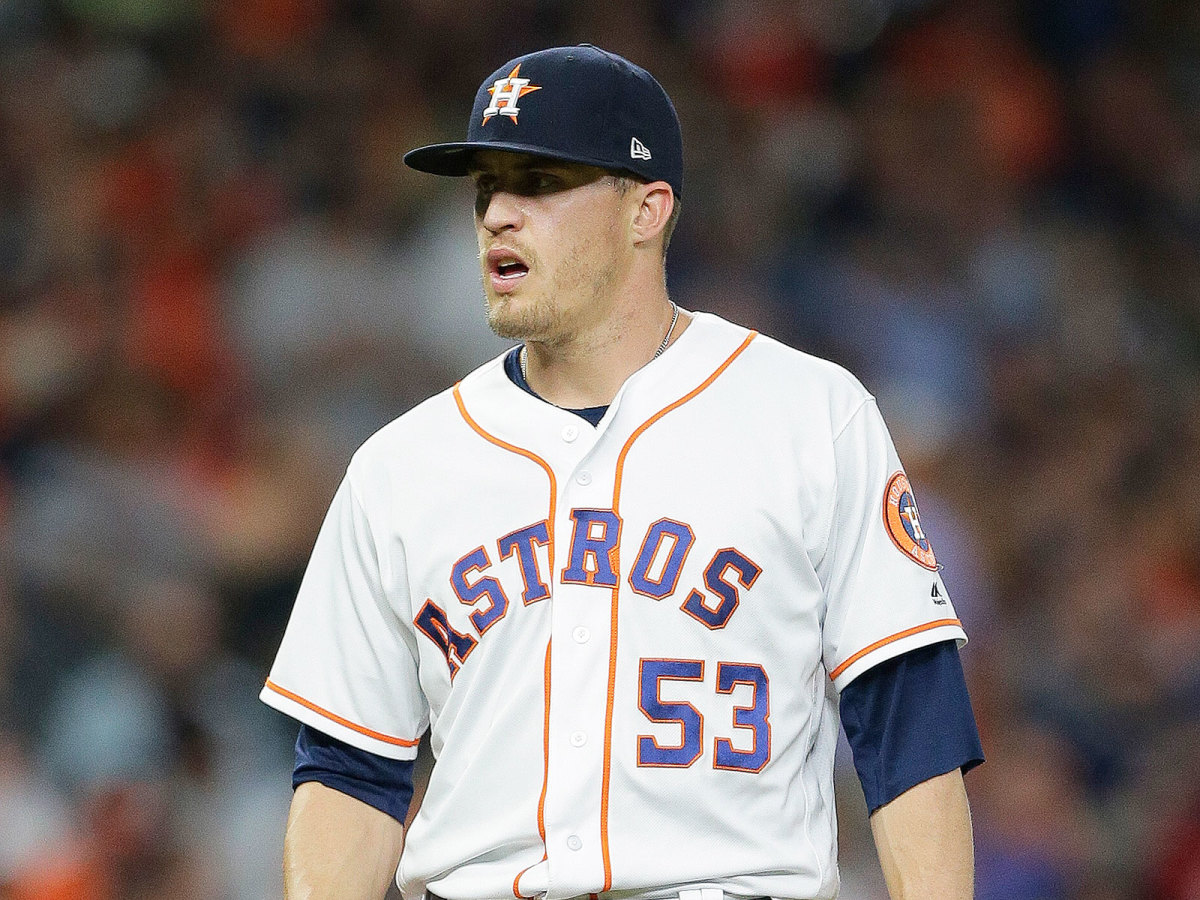
By Tom Verducci
Houston manager A.J. Hinch eased Ken Giles back into a closing role in April, a smart move after Giles crashed in the postseason last year (10 runs in 7 2/3 innings). Giles had one save in the team’s first 25 games. Then, one at-bat against Mike Trout in a save situation April 25 convinced Hinch that Giles was back: Giles perfectly executed three high, 97 mph fastballs to retire Trout on a flyball. In terms of stuff, following a game plan and executing it, Giles could not have been better. In one stretch he retired 19 straight batters.
And then, just like that, it all came undone. Giles’ meltdown May 1—four runs allowed while getting one out and blowing a save against the Yankees, not to mention punching himself in the face as he stomped back to the dugout—caused more uncertainty about how the Astros will close games.
Giles’ worst mistake was a first-pitch slider over the plate to Gary Sanchez with first base open and Aaron Hicks and Miguel Andujar behind him. Catcher Brian McCann actually set a target in the strike zone in what should have been an intentional walk in the first place.
Cardinals' Yadier Molina Out One Month After Surgery
One (very) bad game was enough for Hinch to veer away from Giles, which spoke volumes about the level of trust. Two days later, upon Houston’s next save chance, Hinch tried Will Harris with a two-run lead. Harris was gone without retiring any of three batters, the first of which he walked.
Brad Peacock was next. He allowed all three inherited runners to score.
The Astros have one major flaw right now: the uncertainty about finishing games. They have two and a half months to figure it out. Giles has closer’s stuff, but when his slider rolls instead of drops, he’s in trouble. Peacock showed last postseason he can handle big moments, but he has two career saves, postseason included.
Right now the Astros have the look of the 2016 Cubs: a dynamic team that is postseason bound—maybe even easily so—but harbors nervousness about securing close wins. The 2016 Cubs paid a huge price to cover their flaw with Aroldis Chapman—they gave up Gleyber Torres—but have a flag to show for it.
Houston does not have urgency now. It’s more about sticking with Giles or giving Peacock some run in the ninth. You typically don’t see trades until after the June draft, anyway. But in the meantime, Hinch may have to continue to be creative.
THE PITCHERS WHO INEXPLICABLY SOLVED ICHIRO
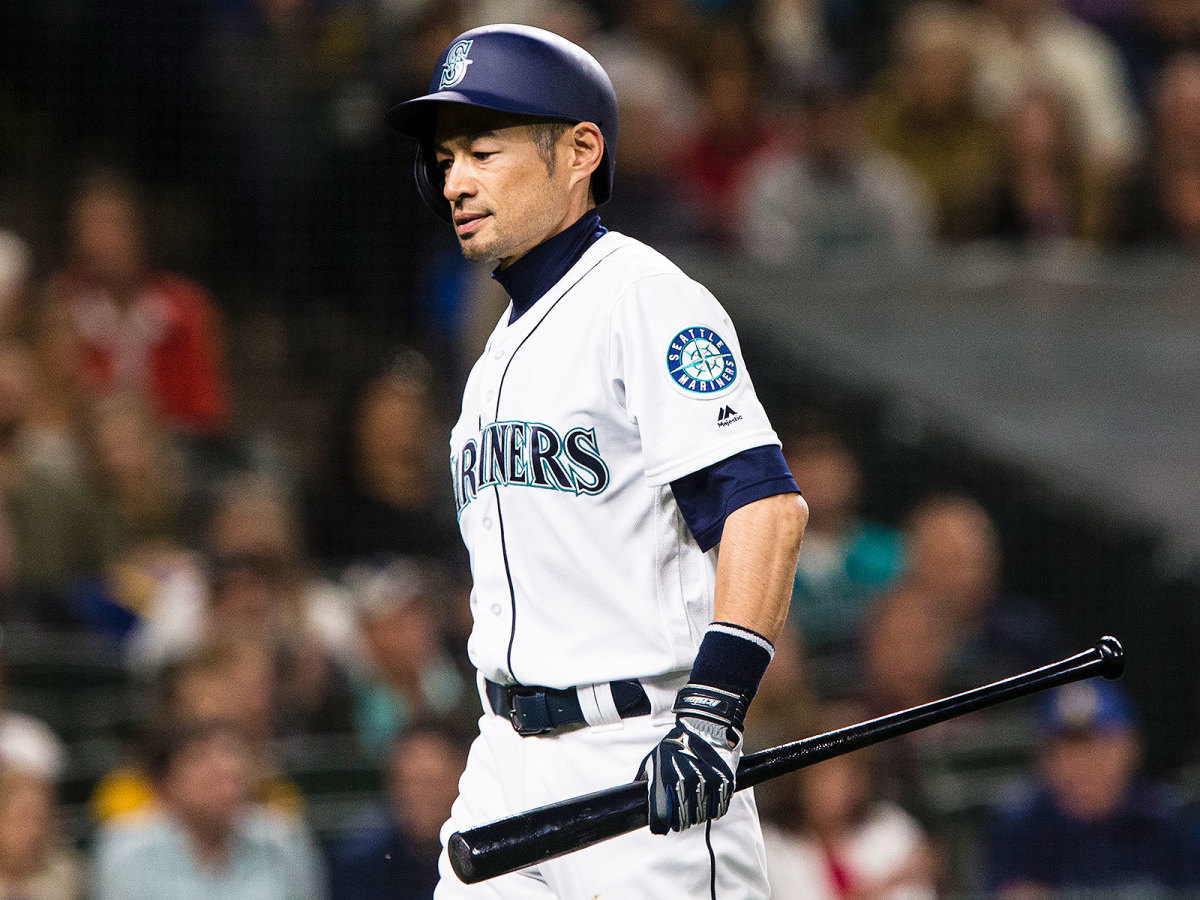
By Jon Tayler
As Ichiro Suzuki steps away from the game (for now), he does so as the owner of a .311 lifetime batting average—18th-best among all players with 10,000 or more plate appearances in MLB history. As you can imagine, one doesn’t get to a .300-or-better average and 3,000-plus career hits without ruining the days or lives of several pitchers in the process, and a glance at Ichiro’s numbers against the hurlers he faced across nearly two decades shows plenty of men who simply couldn’t get him out.
There are some expected names on Ichiro’s list of victims. He hit .632 against soft-tossing former teammate Aaron Sele—the highest mark for Ichiro against any pitcher, minimum 25 plate appearances—and .500 against Vicente Padilla (21 hits in 42 at-bats) and .480 against Aruban punching bag Sidney Ponson. But he also made mincemeat of some of the best his era had to offer: .409 against Mark Buehrle, .364 against Mike Mussina, .351 against Johan Santana. He homered three times off of CC Sabathia en route to hitting .333 against the big lefty, and he owns a .303 career mark against former MVP Justin Verlander.
Ichiro Suzuki Gave Baseball a Model of Consistency and Understated Excellence
But then there are the men whom Ichiro couldn’t solve. Jeremy Hellickson, the otherwise uninspiring righty whose biggest claim to fame is a career record of 69–69, had the best numbers of any starting pitcher against Ichiro (again, minimum 25 PA): a .148 batting average, or four hits in 27 at-bats. (Ex-Angels and Mets closer Francisco Rodriguez has the best results versus Ichiro of any pitcher with 25 or more PA: .074/.138/.074.) Likewise, there’s Rich Harden (.192 in 29 AB) and C.J. Wilson (.196 and a whopping 12 strikeouts in 50 plate appearances), the only other starters to keep Ichiro below .200 in their meetings.
A lock for the Hall of Fame whenever his day comes, Ichiro nonetheless couldn’t always beat the best. Roger Clemens held him to a .200 average. Pedro Martinez diced him up to a .217 average. Roy Halladay had a more pedestrian .262 average against, but Ichiro’s overall line against him resulted in a meager .565 OPS. The one who truly boggles the mind, though, is Chad Gaudin. For those who don’t remember Gaudin, he spent 10 years in the big leagues from 2003 to ’13 as a mediocre fifth starter and long reliever, with opposing batters hitting .267/.348/.420 against him in that span. Yet facing the greatest Japanese major leaguer of all time, he was the second coming of Walter Johnson, limiting Ichiro to a .207/.258/.241 line in 31 plate appearances.
What secret, trick or bit of magic Gaudin deployed to defeat Ichiro so handily, we don’t know. But it’s fun to imagine Ichiro looking back on a career spent torturing starters and relievers alike and wondering why, of all those big names and bigger arms, he could never figure out former 34th-round draft pick and journeyman extraordinaire Chad Gaudin, his most inexplicable nemesis.
ROUNDTABLE: WHAT IS YOUR FAVORITE ICHIRO MOMENT, OR HOW WILL YOU REFLECT ON HIS CAREER?
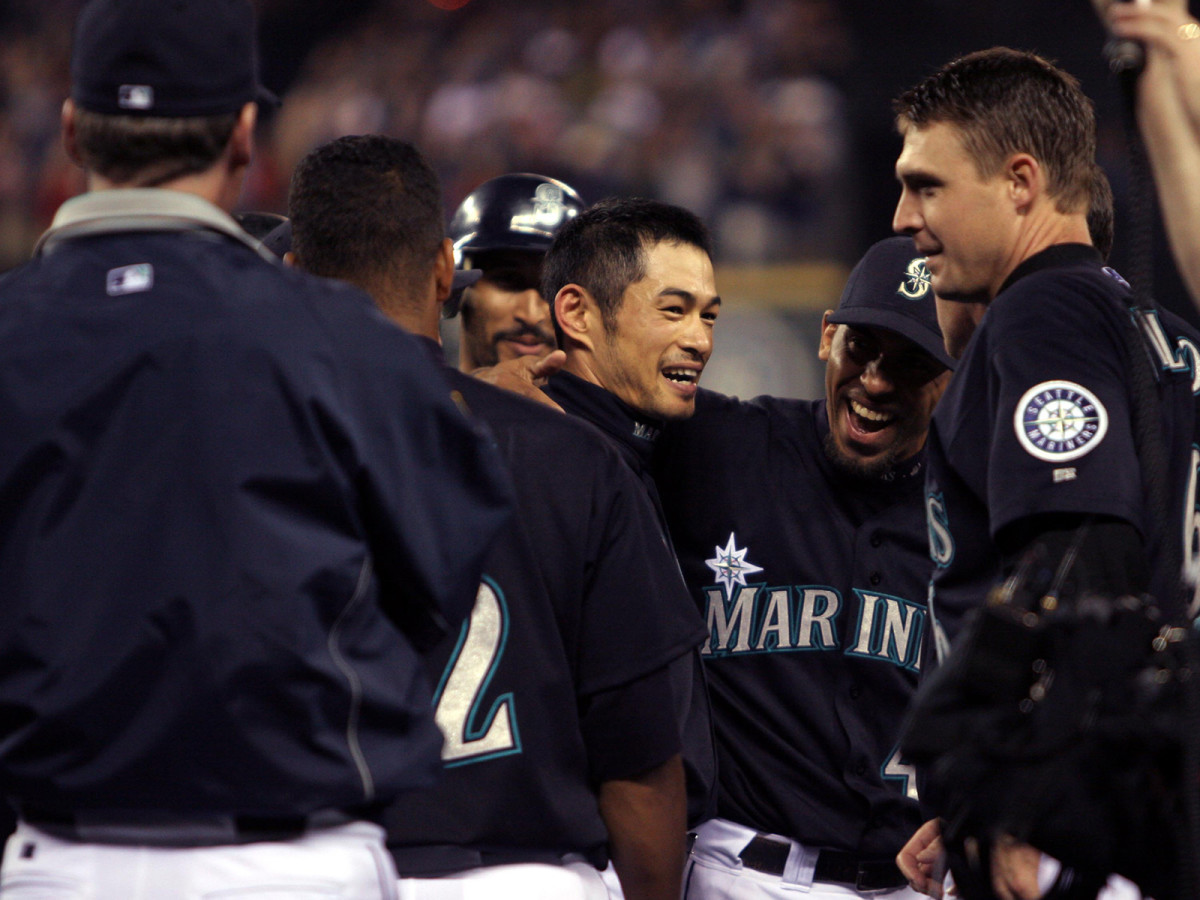
Michael Beller: Rarely does a player etch a line in stone in his scouting report within his first 10 days in the majors. Rarer still, however, are players like Ichiro. Here’s something he did on April 11, 2001, his eighth game in the majors.
From that point forward, few baserunners tried to take an extra base against the Mariners on a hit to right field. Ichiro will go into the Hall of Fame for his mastery with the bat, but he was nearly as good with his glove and his arm for the better part of the last two decades. When he was at the top of his game, few, if any, players were more complete.
Connor Grossman: My favorite Ichiro moment happened one at-bat per year from 2001-2010, when he recorded his 200th hit of the season. It's the benchmark number to any truly great season at the plate, and the future Hall of Famer surpassed it in 10 consecutive seasons. His decade of domination included five straight years of leading the league in hits and a historic 2004 season in which he set the single-season hit record, 262. Pete Rose is the only other player to reach the 200-hit mark 10 times, but he never put together a streak longer than three seasons. We'll miss your greatness, Ichiro.
Jon Tayler: Because neither video nor audio of his wildly profane All-Star Game pump-up speeches exist—“It’s why we win,” said David Ortiz to Yahoo! Sports’ Jeff Passan of Suzuki’s R-rated pre-game missives, back in 2008—I’ll have to default to this moment of Ichiro sharing with Bob Costas and the world his favorite English expression in 2007.
Ichiro was a singular joy to watch on the field, from his surgeon-like approach at the plate to his flawless baserunning to his stellar defense. But from all accounts, it sounds like it was just as much fun to be Ichiro’s teammate, and watch him drop expletive-laden idioms with aplomb. I’ll miss you, Ichiro, even if I never got to hear that vaunted Midsummer Classic speech.
Tom Verducci: My favorite Ichiro Suzuki story goes back to his first spring training with the Mariners, in 2001. Seattle had just plunked down $13.125 million as a posting fee and $14 million to sign him to a three-year deal. His arrival was met with much skepticism – he was the first position player to jump from Japan to MLB – and much of that skepticism was in the Mariners’ own camp.
Suzuki simply kept slapping the ball to the opposite field in batting practice and in games. Mariners manager Lou Piniella, among others in uniform, grew worried about him – worried that major league pitchers could knock the bat out of his hands. Teams began defending him as they might a lefthanded-hitting pitcher.
Finally, before a game in Peoria, Arizona, Piniella used Suzuki’s interpreter to ask him, “Do you ever turn on the ball?”
“Sometimes,” Suzuki said.
First time up, Suzuki pulled a long home run high on a hill in rightfield.
When he reached the dugout he asked Piniella, “Are you happy now, Skip?”
Said Piniella, “You can do anything you want the rest of the year.”
The Best Moments of Ichiro Suzuki's MLB Career Now That His Retirement Is Official
That year Suzuki won the batting title and Rookie of the Year and MVP awards. And among his 242 hits, 45 were to the pull side.
Suzuki made an art of slashing the ball. Because of his speed and “running start” batting style, Suzuki was the rare player who actually benefited from mis-hitting the ball. Almost a quarter of his hits (23%) never left the infield. But when he wanted to, Suzuki could do damage to the pull field.
Suzuki replaced Pete Rose as the player with the lowest slugging percentage who reached 3,000 hits (.402). He was driven by his quest to get 200 hits a year, so he played a contact-driven game that is dying in today’s baseball. But when Suzuki pulled the ball, he slugged .698. Such a skilled craftsman was Suzuki that he could do just about what he wanted with the bat, as Piniella learned in that first spring training.
RANK 'EM: THE BEST ROOKIE SEASONS BY PLAYERS COMING FROM JAPAN
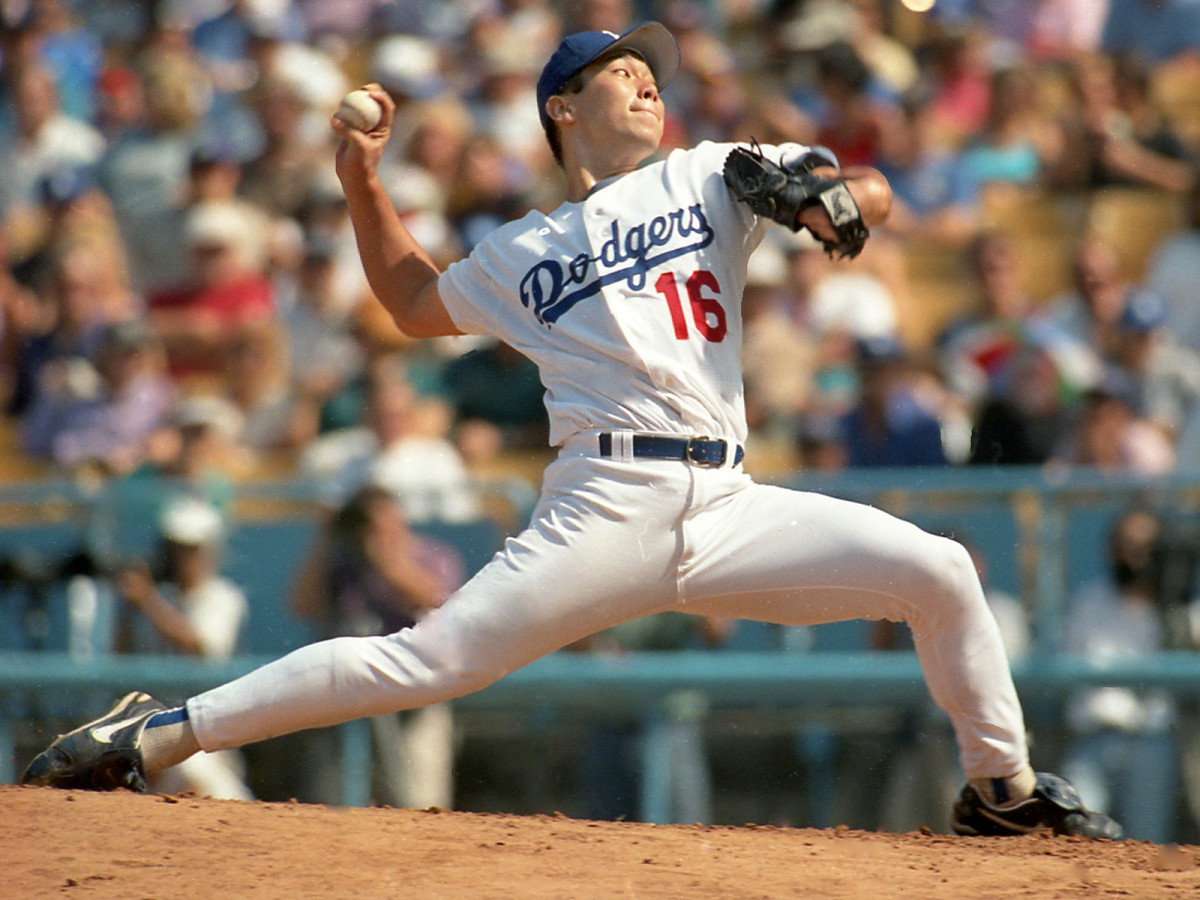
By Gabriel Baumgaertner
Now that Shohei Ohtani is poised to deliver the most memorable rookie season of any Japanese player in Major League history, we take a look back at which players will be mentioned in that conversation once Ohtani's rookie season ends. In December, Jay Jaffe did his ranking before Ohtani made his April debut.
1. Hideo Nomo: Nomo takes the top spot not because he had a better rookie season than Ichiro, but because he did so under some of the greatest scrutiny that any international player had faced in Major League history. Ballyhooed by both the Japanese and American media upon his arrival at age 26, Nomo won the 1995 NL Rookie of the Year, finished fourth in Cy Young voting and was elected an All-Star. He led the league in strikeouts with 236, had 11 starts with 10 strikeouts or more and threw at least eight innings in every start in June. Nomo did all of this while seemingly having his every move documented by the visiting Japanese press.
2. Ichiro Suzuki: This isn’t one of the best rookie seasons in history or best seasons by a Japanese player; it’s one of the most memorable individual seasons of the past two decades. Facing big league pitching for the first time at 27, Ichiro compiled 242 knocks, hit .350, stole 56 bases and struck out in just 7% of his plate appearances. On a team that won 116 games, Ichiro was the star who won AL MVP and Rookie of the Year in addition to earning All Star, Silver Slugger and Gold Glove honors in his first year. He also uncorked one of the most beautiful throws most of us have ever seen.
3. Kaz Sasaki: Sasaki arrived in 2000 at age 32 and would go on to save 37 games (a rookie record) and win AL Rookie of the Year with the Mariners. Sasaki only pitched four seasons in the big leagues, but was one of the game’s most feared closers in three of them.
4. Akinori Otsuka: For two seasons, Otsuka was one of the National League’s most feared setup men. As a 32-year-old rookie with the Padres, he logged a 1.76 ERA and a K/9 rate of 10.8 over 73 outings. His 2.9 WAR was the highest of any pitcher except ace Jake Peavy. In the offseason before the 2006 season, Otsuka was shipped to Texas as part of the deal that brought Adrian Gonzalez to San Diego.
5. Hideki Matsui: Like Nomo, Matsui was one of Japan’s biggest celebrities when he arrived in the United States in 2003. As a 29-year-old rookie, Matsui narrowly finished second in the AL Rookie of the Year voting behind Royals shortstop Angel Berroa. If the two compiled the same seasons in 2018, it’s almost certain Matsui would win the award. While he finished with a modest 16 home runs, Matsui displayed what would be his best asset over his 10-year MLB career, which was his eye. Matsui took 63 walks and struck out just 83 times, which resulted in a .353 OBP to complement his .287 batting average.
Which Active MLB Player Has the Most Hits?
6. Shingo Takatsu, 2004: He only pitched two seasons in the big leagues, but his rookie campaign as a 35-year-old member of the White Sox almost earned the little-known reliever a Rookie of the Year award. Takatsu finished a distant second behind A’s shortstop Bobby Crosby, but delivered a dominant month in the middle of the season in which he didn’t allow a baserunner. From May 28-June 19, Takatsu pitched a perfect 7.1 IP. Over 25 games from May 21-August 6, Takatsu allowed just two runs. He’d be traded the next year to the Mets, but Takatsu was a lot like Koji Uehara—an older Japanese reliever who was an excellent relief option for a big league team.
7. Masahiro Tanaka: Unlike most of his predecessors, Tanaka was being paid a $22 million annual salary before he threw a major league pitch. While he didn’t dominate the way many expected him to, he finished his rookie season with a 2.77 ERA over 20 starts. While he’s still one of the most capable “stuff” guys in the big leagues, Tanaka’s rookie campaign was his most consistent.
8. Takashi Saito: Saito arrived in Los Angeles at age 36 to take over the closer role vacated by Eric Gagne. He replaced the most popular Dodger of the decade by compiling a 2.07 ERA and a 12.3 K/9 rate in 2006, finishing eighth in NL Cy Young voting and seventh in NL Rookie of the Year polling. Despite arriving in the big leagues at 36, Saito pitched in seven big league seasons and retired with an ERA of 2.34 and a K/9 rate of 10.7.
9. Tad Iguchi: Iguchi had the good fortune of winning the World Series in his rookie season as a member of the White Sox. He finished fourth in the 2005 AL Rookie of the Year Voting after hitting 15 home runs, stealing 15 bases and finishing third on the team with a .746 OPS.
SILVER LININGS: ONE REASON TO WATCH TEAMS THAT ARE OUT OF IT
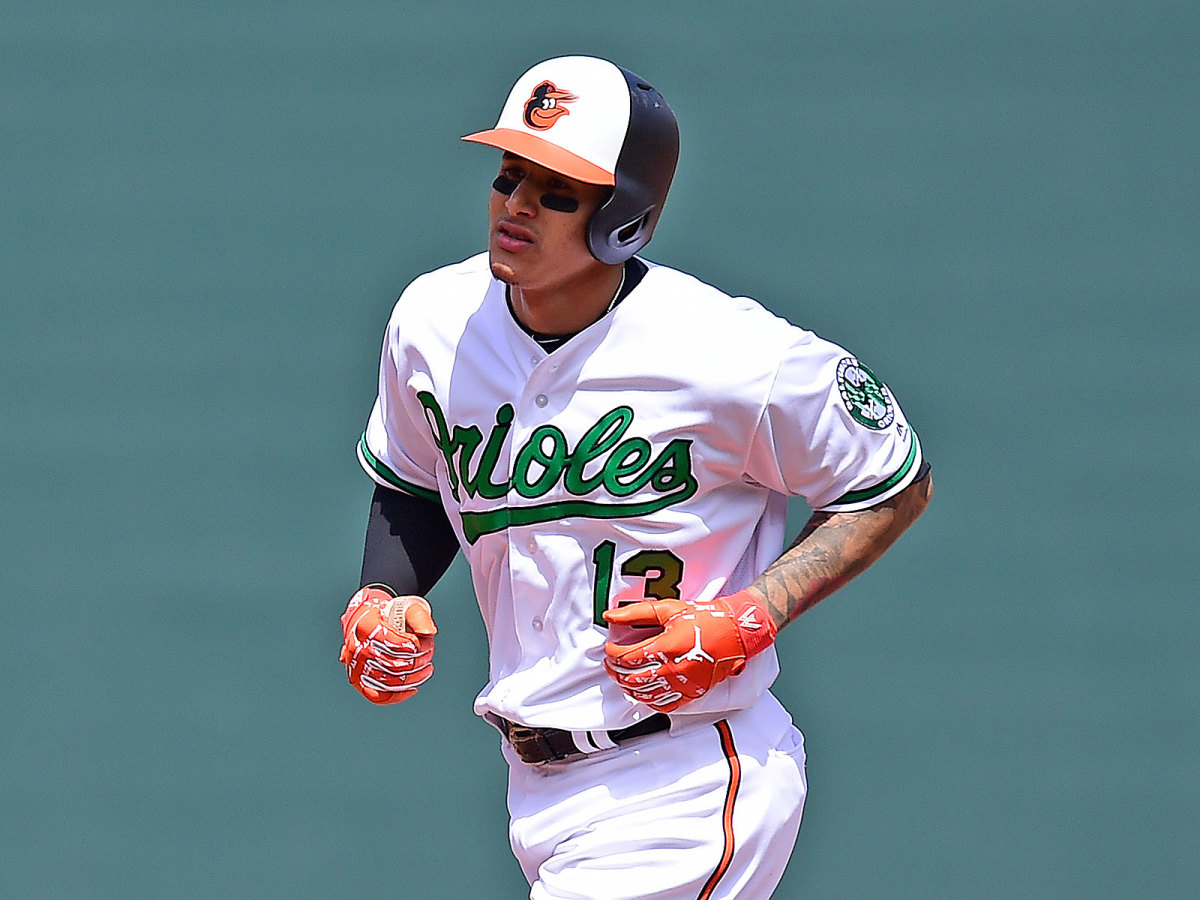
By Michael Beller
With more teams than ever before not trying to win, it’s no surprise that the season is all but over already for at least six teams. But never fear, fans of the White Sox, Royals, Orioles, Marlins, Reds and Padres, this won’t be a totally lost year. Each of your teams has something to enjoy this season. We’re here to provide those silver linings.
White Sox: Tim Anderson is off to an electric start to the season: six homers, eight steals and a .462 slugging percentage through 127 plate appearances. He’s still striking out a bit too often, but he’s making clear that he can be a key part of the team’s rebuild in his age-25 season. While the trade returns for Chris Sale, Jose Quintana and Adam Eaton have received most of the attention, the homegrown Anderson is growing into an impact player in his third season.
Royals: Kansas City took a chance on a former top prospect when they dealt Wade Davis for Jorge Soler before last season. Soler spent much of his first season in Kansas City on the DL, but he is breaking out this season, hitting .297/.415/.505 with four homers in 123 plate appearances. It will be a while before the Royals are contenders again, but at least their fans will get to watch Soler launch rockets like this:
Orioles: For about half of this decade, Manny Machado has delivered fans the joy of watching a superstar every day. That era will almost certainly end before the July 31 trade deadline. It will be a shame to see him go elsewhere, but that doesn’t mean we should overlook what he does while he’s still in Baltimore. So, Orioles fans, as bittersweet as the next few months will likely be, enjoy Machado as your guy while you still can.
Marlins: The Marlins don’t get to protect a ton of leads, but that doesn’t make their bullpen any less fun, thanks to its three-headed strikeout monster. Drew Steckenrider, Tayron Guerrero and Kyle Barraclough have combined for 74 strikeouts in 45 innings this season. That’s good for a 14.8 K/9 to go along with a 39.2% strikeout rate. Even when they aren’t missing bats in service of a win, it’s a show when Steckenrider, Guerrero and Barraclough are getting whiff after whiff…after whiff after whiff.
Reds: Despite Joey Votto’s slow start to this season, he remains one of the league’s true artists in the batter’s box. No matter how often we’ve seen it, our appreciation for it should not diminish. Not only is Votto still underappreciated, Eugenio Suarez, too, is one of the most underappreciated players in the league. Reds fans, don’t make the same mistakes that too many other fans do. Appreciate your corner infielders.
Padres: This is an easy one. After all, the Padres have someone doing this:
ChristianVillanueva and his hilariously massive home runs will guarantee that this is not a boring summer in San Diego, even if the wins are few and far in between.
FROM THE VAULT: CELEBRATING THE BRILLIANT TONY GWYNN
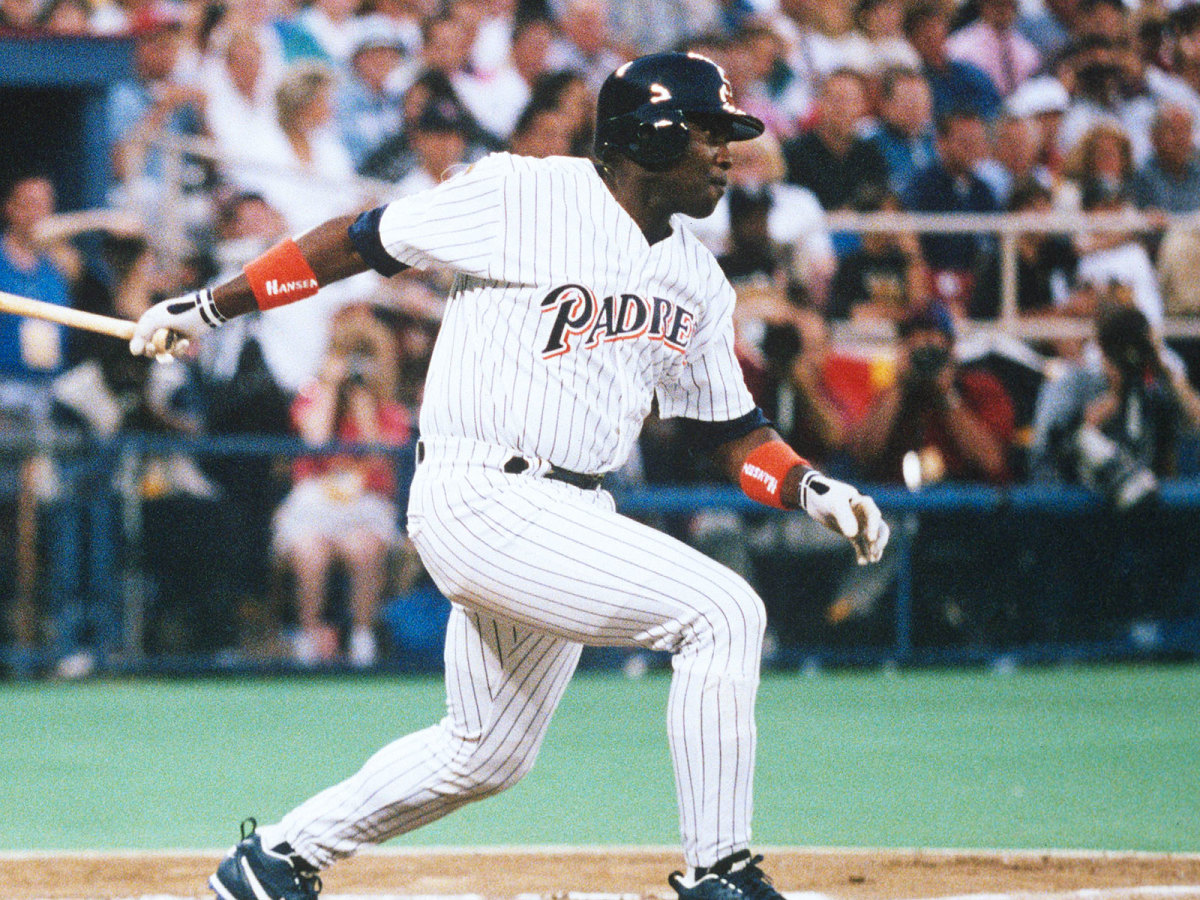
By Connor Grossman
In the spirit of toasting Ichiro as one of the game's greatest hitters, it's only appropriate to acknowledge a similarly great player who Ichiro will eventually join in Cooperstown. The late, great Tony Gwynn would have turned 58 on Wednesday. Mr. Padre passed away in June 2014 after a lengthy bout with cancer. In a 20-season career he won eight batting titles, hit over .300 in 19 (!) straight seasons never struck out more than 40 times (!!) in one year. He earned 15 All-Star selections, five Gold Gloves and exactly one top three MVP finish.
Tom Verducci dove into the late stages of Gwynn's career for a 1997 SI cover story that proclaimed him as "The Best Hitter Since Ted Williams." It's hard to argue. Give the piece a read over here, or enjoy the excerpt below.
Padre Time marches on. The lefthanded hitting Gwynn is better than ever, a stunning development for someone who has batted against pitchers born during World War II; has undergone three operations on his left knee and one for a partially torn right Achilles tendon; has carried too much weight, as much as 220 pounds, on his 5'11" frame; and, at 37, is older than Don Mattingly, who is already two years into retirement. Yet here he is threatening to put up numbers for 1997 that would be as round as the shadow he casts: 250 hits, 100 runs batted in, 20 home runs and a .400 batting average, the magical figure not reached in the 56 years since Ted Williams batted.406.
“It’s the kind of year that I’ve dreamed about my whole career,” Gwynn says. “It says people have to give me credit for my work ethic, even though I don’t look like I have much of one. It says what I’ve been doing the last few years has paid off.”
San Diego signed Gwynn in spring training to an extension that will pay him an average of $4.2 million a season through 2000, when he turns 40. “I’ll play past that,” he says. Adds Padres president and CEO Larry Lucchino, “It reminds me of what they said about General Grant’s drinking: ‘Give me generals who all drink the same thing.’ Well, I’ll take players with the same diet as Tony’s.”
